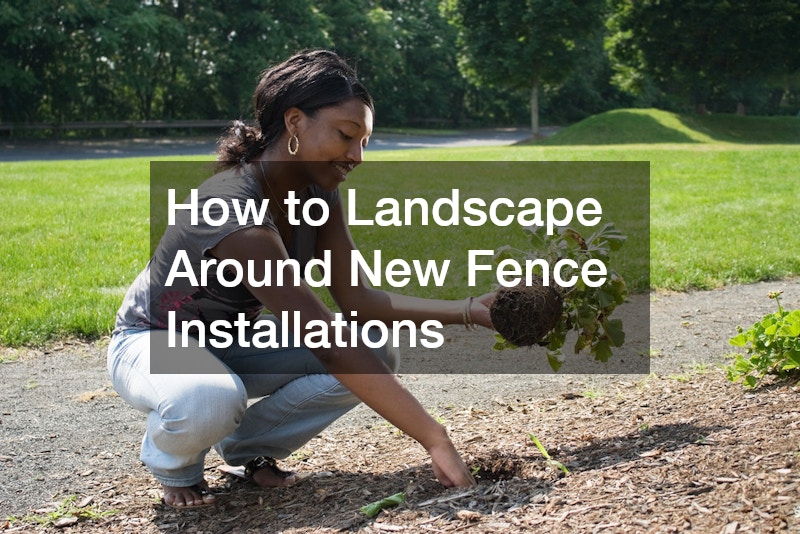Landscaping around a new fence installation can significantly enhance the aesthetics of your outdoor space, provide additional privacy, and increase the overall property value. However, planning the landscape to complement the fence and surrounding environment requires careful consideration. This guide offers practical steps on how to effectively landscape around new fence installations, ensuring a seamless and visually appealing outdoor design.
How to Choose the Right Plants for Fence Line Landscaping
Understanding Microclimates
Before selecting plants, it’s crucial to assess the microclimate of the area near the fence. Factors such as sun exposure, wind patterns, and soil conditions will influence plant selection.
South-facing fences receive ample sunlight, while north-facing fences tend to be shaded.
Native vs. Non-Native Plants
Opting for native plants can make maintenance easier since they are well-adapted to the local climate and soil. Non-native plants may require additional care but can introduce unique aesthetics and biodiversity.
Maintenance Considerations
Choose plants that align with your maintenance capabilities. Some plants require frequent pruning and watering, while others thrive with minimal upkeep. Low-maintenance options like ornamental grasses or perennials can be ideal.
Planting for Privacy
Tall shrubs, climbing vines, and bamboo are excellent choices for enhancing privacy. Consider fast-growing options such as arborvitae or holly for a natural green screen.
Seasonal Plantings
Integrating a variety of plants that bloom in different seasons ensures year-round interest. Evergreen plants provide greenery in winter, while flowering species can add seasonal color.
What Are the Best Design Principles for Landscaping Along a Fence?
Symmetry vs. Asymmetry
Decide whether a symmetrical or asymmetrical design suits your space. Symmetrical planting creates a formal, balanced look, while asymmetry adds a more natural, dynamic feel.
Color Coordination
Harmonize plant colors with the fence and surrounding landscape. Neutral-colored fences allow for vibrant plant choices, while colorful fences pair well with subdued plant palettes.
Texture and Layering
Mixing different textures, such as soft foliage with rough bark, creates visual depth. Layer plants by height, with taller plants in the back and shorter ones in the front, to achieve a tiered effect.
Creating Focal Points
Introduce eye-catching elements like a flowering vine-covered trellis, a decorative garden bench, or a water feature to break up monotony and draw attention.
Incorporating Hardscapes
Elements like stone pathways, decorative edging, or wooden planters can add structure and contrast to the landscape, making the fence area more engaging.
How to Incorporate Trees and Shrubs Effectively
Choosing the Right Tree Species
Select tree species based on growth habits and compatibility with fence structures. Avoid trees with invasive roots that could damage foundations or fencing materials.
Shrub Placement for Maximum Impact
Strategically placing shrubs along the fence can soften its appearance. Grouping shrubs in odd numbers creates a more natural look.
Root Management Techniques
To prevent root overgrowth, plant trees and shrubs at a safe distance from the fence and use root barriers if necessary.
Seasonal Pruning Practices
Regular pruning helps maintain plant health and prevents overgrowth that may obstruct or damage the fence. Schedule seasonal trims to encourage optimal growth.
Integrating with Existing Vegetation
Blend new plantings with existing landscape elements to create a cohesive outdoor space. Consider repeating colors or plant species to establish continuity.
What Are the Maintenance Tips for Landscaping Along a Fence?
Regular Pruning and Trimming
Keep plants well-maintained to prevent them from overgrowing into the fence. Routine trimming helps maintain a tidy appearance and promotes healthy growth.
Soil and Fertilization
Enhance soil quality with compost and appropriate fertilizers to ensure plant vitality. Conduct soil tests to determine necessary amendments.
Pest and Disease Management
Regularly inspect plants for signs of pests or diseases. Implement natural pest control methods or use eco-friendly pesticides to protect your landscape.
Irrigation and Water Management
Install drip irrigation or soaker hoses to provide consistent moisture without overwatering. Ensure proper drainage to prevent root rot.
Mulching for Healthier Plants
Applying mulch around plant bases conserves moisture, suppresses weeds, and improves soil health. Organic mulches like wood chips or bark decompose over time, enriching the soil.
How to Incorporate Lighting Around Fence Landscapes
Choosing the Right Lighting Styles
Select lighting fixtures that complement the overall landscape design. Options include lantern-style lights, string lights, and in-ground pathway lights.
Installation Tips
Position lights strategically to highlight key areas such as pathways, focal points, or climbing plants. Use weather-resistant fixtures for durability.
Solar vs. Electric Options
Solar lights are energy-efficient and easy to install, while electric lights provide consistent illumination. Choose based on your energy preferences and landscape layout.
Lighting for Security and Ambiance
Use bright motion-sensor lights for security and softer, warm-toned lights for ambiance. Layer different lighting intensities to achieve a balanced effect.
Maintenance of Outdoor Lighting
Regularly clean fixtures and replace bulbs as needed. Check for wiring issues and ensure solar panels receive adequate sunlight for charging.
Landscaping around a new fence installation enhances curb appeal and creates a cohesive outdoor environment. By selecting suitable plants, applying thoughtful design principles, maintaining greenery, and incorporating lighting, you can transform your fence line into a functional and visually appealing space. Planning carefully and maintaining regularly ensures lasting beauty and value for your landscape.
.

